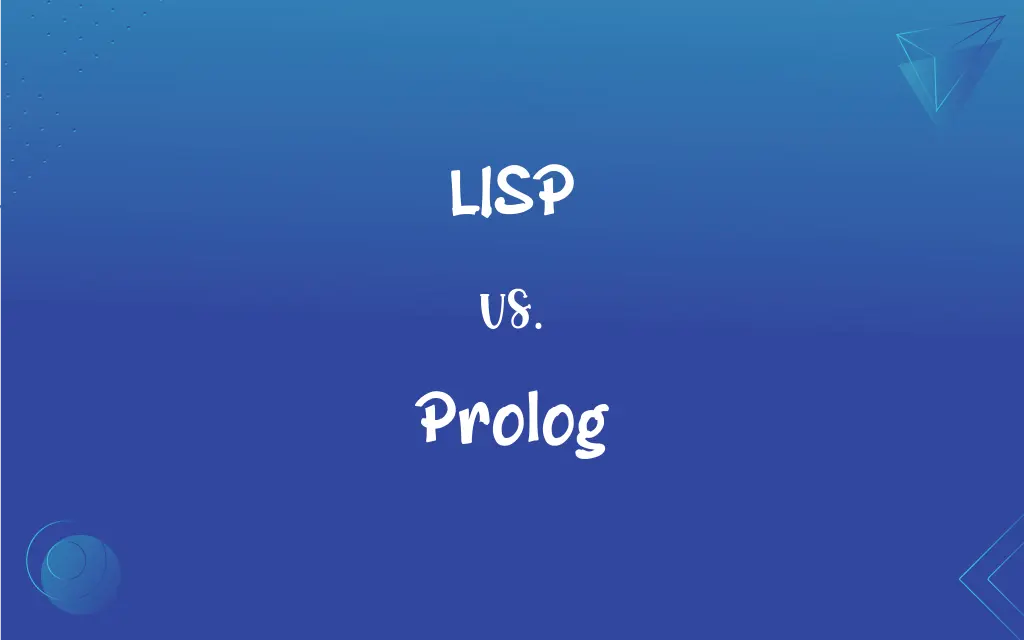LISP vs. Prolog: What's the Difference?
Edited by Aimie Carlson || By Harlon Moss || Published on May 14, 2024
LISP is a functional programming language focused on recursion and symbolic processing, while Prolog is a logic programming language used for solving problems with facts and rules.

Key Differences
LISP, developed in the late 1950s, is one of the oldest high-level programming languages, primarily used for artificial intelligence (AI) and symbolic processing. Prolog, developed in the 1970s, is a logic programming language designed for computational linguistics and AI, emphasizing on declarative problem-solving.
LISP is known for its functional programming approach, enabling functions to be used as data and emphasizing recursion and list processing. Prolog, on the other hand, follows a declarative paradigm, where logic and relationships are defined through facts and rules, and the language itself deduces the solutions.
LISP's syntax is characterized by its use of parentheses and prefix notation, making it highly flexible and adaptable for symbolic computation. Prolog uses a more straightforward syntax based on facts and rules, expressed in a form resembling natural language sentences.
In LISP, data is predominantly managed through lists and symbolic expressions, which are fundamental to the language's structure. Prolog relies heavily on facts and rules for data representation, using a database-like structure to store and manipulate knowledge.
LISP is often employed for tasks requiring recursive algorithms and complex data structures, like AI applications and machine learning. Prolog is uniquely suited for problems that can be expressed in terms of relationships and logic, such as expert systems and natural language processing.
ADVERTISEMENT
Comparison Chart
Primary Use
AI, symbolic processing, functional programming
Logic programming, AI, computational linguistics
Programming Style
Functional, with recursion and list processing
Declarative, based on facts and rules
Syntax
Parentheses-heavy, prefix notation
Fact and rule-based, resembling natural language
Data Representation
Lists and symbolic expressions
Database-like facts and rules
Problem Solving
Recursive algorithms, symbolic computation
Logical deduction, relational problem-solving
ADVERTISEMENT
LISP and Prolog Definitions
LISP
LISP is a pioneering language in the field of artificial intelligence research.
Many early AI algorithms were originally written in LISP.
Prolog
Prolog is widely used in AI for creating systems that reason with knowledge bases.
Our AI uses Prolog to reason about its knowledge base efficiently.
LISP
LISP is a high-level, functional programming language primarily used for artificial intelligence.
We used LISP to develop an advanced AI system.
Prolog
Prolog is a logic programming language used for solving problems based on facts and rules.
We implemented an expert system using Prolog.
LISP
LISP is known for its unique use of symbolic expressions and lists.
Symbolic processing in LISP enables powerful data manipulation.
Prolog
Prolog excels in natural language processing and computational linguistics.
Prolog's pattern matching capabilities make it ideal for parsing human language.
LISP
LISP's syntax is characterized by its extensive use of parentheses.
LISP programs are easily recognizable by their nested parentheses.
Prolog
Prolog's declarative nature allows for expressing what to solve, rather than how to solve it.
With Prolog, we defined the problem, and the language figured out the solution.
LISP
LISP allows functions to be treated as data, enabling flexible programming patterns.
In LISP, we created functions that generate other functions dynamically.
Prolog
In Prolog, programs are expressed as a series of logical relationships.
The Prolog program deduced the solution through its rule-based logic.
LISP
One of the first high-level programming languages, designed to handle complex data structures. It is widely used in artificial intelligence research.
Prolog
(computing) A component of a computer program that prepares the computer to execute a routine.
LISP
A high-level computer programming language in which statements and data are in the form of lists, enclosed in parentheses; - used especially for rapid development of prototype programs in artificial intelligence applications .
Prolog
A declarative higher-level programming language in which instructions are written not as explicit procedural data-manipulation commands, but as logical statements. The language has built-in resolution procedures for logical inference.
Prolog
A computer language designed in Europe to support natural language processing
FAQs
How does LISP handle data?
LISP mainly uses lists and symbolic expressions for data handling.
Can LISP treat functions as data?
Yes, LISP can treat functions as data, allowing for highly flexible programming.
What makes LISP's syntax unique?
LISP's syntax is unique for its extensive use of parentheses and prefix notation.
Is LISP still used today?
Yes, LISP is still used, especially in AI research and specialized applications.
Is Prolog a procedural or declarative language?
Prolog is a declarative language, focusing on the logic of the program.
What is LISP primarily used for?
LISP is primarily used for artificial intelligence, symbolic processing, and functional programming.
How does Prolog represent knowledge?
Prolog represents knowledge using facts and rules in a database-like structure.
What type of syntax does Prolog use?
Prolog uses a syntax based on facts and rules, resembling natural language.
Can LISP be used for web development?
While not common, LISP can be used for web development, particularly with frameworks designed for it.
What is Prolog best suited for?
Prolog is best suited for logic programming, AI, and computational linguistics.
Can Prolog handle natural language processing?
Yes, Prolog is particularly effective at natural language processing.
How does problem-solving differ in LISP and Prolog?
LISP uses recursive algorithms and symbolic computation, while Prolog uses logical deduction and relational problem-solving.
Are LISP and Prolog still relevant today?
Yes, both LISP and Prolog are still relevant, especially in specialized fields like AI.
Can Prolog reason with a knowledge base?
Yes, Prolog can efficiently reason with and query a knowledge base.
How are functions treated in LISP?
In LISP, functions are first-class citizens and can be manipulated like any other data.
What makes Prolog unique in AI programming?
Prolog's uniqueness lies in its ability to solve problems by defining relationships and rules.
Is Prolog efficient for database-like applications?
Yes, Prolog's structure makes it efficient for applications resembling databases.
How does LISP's approach to AI differ from Prolog's?
LISP's approach is more about recursive algorithms and symbolic AI, whereas Prolog focuses on logic and rule-based AI.
What is the learning curve for LISP compared to Prolog?
LISP's learning curve can be steep due to its unique syntax, while Prolog's declarative style might be more intuitive for some.
What kind of programming paradigm does LISP follow?
LISP follows a functional programming paradigm.
About Author
Written by
Harlon MossHarlon is a seasoned quality moderator and accomplished content writer for Difference Wiki. An alumnus of the prestigious University of California, he earned his degree in Computer Science. Leveraging his academic background, Harlon brings a meticulous and informed perspective to his work, ensuring content accuracy and excellence.
Edited by
Aimie CarlsonAimie Carlson, holding a master's degree in English literature, is a fervent English language enthusiast. She lends her writing talents to Difference Wiki, a prominent website that specializes in comparisons, offering readers insightful analyses that both captivate and inform.






































































